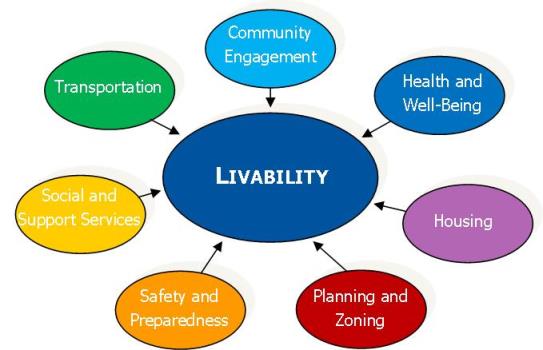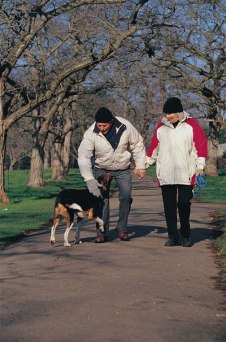Community Conversation

Starting a Community Conversation
The first step in making a community more livable is convening community stakeholders for a thoughtful conversation. To get started:
- Personally invite community residents, including a broad range of local and regional leaders from across sectors, including representation from private businesses, nonprofits, and religious institutions, among others.
- Select conversation facilitators who can remain neutral, build trust, and push participants to consider different perspectives.
- Provide an overview of the community’s demographic composition and describe the concept of a livable community.
- Lead the conversation and identify themes for further inquiry.
Resources
Assessment
Conducting an Assessment
Areas of Intervention to Create Livable Communities – Early on, it is necessary to conduct a regional or local assessment to:
- Identify areas for policy and programmatic intervention, and
- style=”text-align: center;”>Determine if additional data collection is needed to understand a given community’s facilitators and barriers to aging in place.

Resources
Some tools to conduct an initial community assessment are listed below. Many provide low-cost methods for local governments to begin examining the needs of their aging population. Which assessment tools are best applied in which settings is discussed in a recently published community assessment guide.
- Shaping Livable Communities and Promoting Aging in Place
- Vital Communities Assessment
- AARP Survey of Community Residents Ages 50 and Older
- Sustainable Communities Indicators
- Is This is a Good Place to Live? Measuring Community Quality of Life for All Ages
- World Health Organization Checklist of Essential Features of Age-friendly Cities
- World Health Organization’s Measuring the Age-Friendliness of Cities: A Guide to Using Core Indicators
- Community Report Card (City Leaders Institute)
- Best Cities for Successful Aging: Indicators in Methodology
- Livable Community Indicators for Sustainable Aging in Place
- The Advantage Initiative
- Urban Health Equity Assessment Response Tool
Planning and Implementation
Make a Plan and Get Going

After conducting a community conversation and an initial assessment, communities are encouraged to identify priorities, determine SMART objectives, and determine who will be responsible for each aspect of implementation. Depending on available resources, communities may wish to implement changes incrementally, and if necessary, focus on low-cost changes first.
Once you have a plan… now what?
- The most successful implementers of livable community initiatives have strong processes for systemically measuring and evaluating progress toward goals, and revisiting and adjusting the original plan as necessary.
- Depending on the objectives defined, implementation may require shifting finances or acquiring new resources to support goals.
- Funding opportunities potentially available from a broad range of partners looking to support initiatives to create more livable communities, including the federal and state government, philanthropic organizations, private businesses, and nonprofit organizations.
Resources
- Aging in Place: A Toolkit for Local Governments
- Aging in Place: A State Survey of Livability Policies and Practices
- Making Your Community Livable for All Ages: What’s Working!
- AARP Policy Book 2013-2014: Livable Communities
- The Maturing of America: Communities Moving Forward for an Aging Population Overview: Planning for Multigenerational Communities
- Multi-general community planning: Linking the needs of children and older adults
- Creating a Livable Community: Engaging All Generations and Improving Quality of Life
- World Health Organization’s Global Age-friendly Cities: A Guide
- A Blueprint for Action: Developing Livable Communities for All Ages
- Naturally Occurring Retirement Communities Blueprint: A Guide to Community Action
- Age-Friendly Communities: The Movement to Create Great Places to Grow Up and Grow Old in America
Funding

Communities can begin creating livability through low-cost strategies. But funding opportunities are available as well from a broad range of partners, including the federal and state government, philanthropic organizations, private businesses, and nonprofit organizations.
- The U.S. Department of Housing and Urban Development is making $15 million available to help low-income older adults age in place with supportive services. Applications are due April 18, 2016. For more information, please click here.
- The Connecticut Department of Housing has announced pre-development funding for the Incentive Housing Zone (HOMEConnecticut) program, the goal of which is to create affordable housing that is sustainable by including it within mixed-income developments. Applications are being accepted on an ongoing basis. For more information, please click here.
- The Connecticut Humanities Fund (CTHF) awards grants for humanities programs that interpret our history, explore contemporary themes, and engage broad audiences in public discourse. To learn more, please click here.
- The Arts Catalyze Placemaking program provides investments in arts-based cultural activities and infrastructure to advance the attractiveness and competitiveness of Connecticut’s cities, towns and villages. To learn more about the next grant cycle, please click here.
- Rebuilding Together, Hartford’s home modification program, is designed to enhance the ability of older persons and younger persons with disabilities to remain in their homes and prevent unnecessary institutionalization. For more information, click here.
Resources
- Fuss & O’Neill Complete Streets Funding Sources
- Connecticut Office of Legislative Research: State Grants for Municipalities
- Connecticut Conference of Municipalities: Grant Opportunities
- Funders at Work in Aging in Connecticut
- TIGER Discretionary Grants
- Fundsnet Services
- Weaving it Together: A Tapestry of Transportation Funding for Older Adults
Resources
Definitions
Legislative Resources
Community Engagement
- The Intergenerational Center at Temple University: Connecting generations to strengthen communities
- Generations United
- Civic Engagement and Recent Immigrant Communities: A planning guide for local officials and other community leaders (with broader applications beyond immigrant communities)
- The Role of Local Elected Officials in Economic Development
- Encore: Second Acts for the Greater Good
- Older Adults as Engaged Volunteers
Health Services
- Connecticut State Health Assessment and Improvement Plan
- Healthy Connecticut 2020 Performance Dashboard
- A Sustainability Planning Guide for Healthy Communities
- Healthy Planning Guide
- Housing and Health: New Opportunities for Dialogue and Action
- Understanding the Role of Community Development Finance in Improving Access to Healthy Food: A Guide for Public Health Practitioners
- Bicycling and Walking in the United States: 2014 Benchmarking Report
- National Prevention Strategy: America’s Plan for Better Health and Wellness
- Healthy People 2020 Topic Area, Older Adults
- The HIA [Health Impact Assessment] Process
Housing
- Connecticut Fair Housing Center’s People, Place and Opportunity: Mapping Communities of Opportunity in Connecticut
- 2015 Connecticut Housing Data Profiles (Partnership for Strong Communities)
- Partnership for Strong Communities’ Housing in CT 2014
- Housing America’s Older Adults: Meeting the Needs of an Aging Population
- Increase the Availability of Affordable Homes Toolkit
- Meet the Housing Needs of Older Adults Toolkits
- Accessory Apartments (Fact sheet)
- Shared Housing (Fact sheet)
- Cohousing Association of the United States: What is Cohousing?
- Fair Housing Accessibility FIRST
- Home Fit Guide
- National Resource Center on Supportive Housing and Home Modification: Guide to Home Modification
- National Association of Homebuilders Aging-in-Place Specialist Certification
Planning and Zoning
- Fiscal Implcations of Development Patterns
- Conservation and Development Policies: The Plan for Connecticut (2013-2018)
- Sustainable Land Use Code Project. Model Regulations
- Capitol Regional Green Clearinghouse
- Promoting Housing Options for Older Adults through Zoning
- Promote Sustainable and Equitable Development Toolkit
- Halfway There: How to Create Land Use Policy That Makes the Most of Connecticut’s Transit Network
- Multigenerational Planning: Using smart growth and universal design to link the needs of children and the aging population
- American Planning Association Smart Growth Policy Guide
- American Planning Association Aging in Community Policy Guide
- The Smart Growth Network
- Change Lab Solutions’ Pedestrian Friendly Code Directory
- Health Impact Assessment Fact Sheet
Public Spaces and Buildings
- Placemaking for an Aging Population: Guidelines for Senior-Friendly Parks
- Streets as Places: Using Streets to Rebuild Communities
- Model Joint Use Resolution
- This Land is Our Land: A Primer on Public Land Ownership and Opportunities for Recreational Access
- Building in Healthy Infill: A Guide for Improving Public Health Through Development
- Dig, Eat and Be Healthy: A Guide to Growing Food on Public Property
- The ADA and City Governments: Common Problems
- Americans with Disabilities Act: ADA Guide for Small Towns
- ADA Update: A Primer for Small Business
Social Services
- County Health Rankings & Roadmaps: Integrate social services
- Naturally Occurring Retirement Community Aging in Place Initiative
- Village to Village Network
- Helping Caregiving Families
Transportation
- NACTO Urban Street Design Guide
- Evaluating Complete Streets Projects: A Guide for Practitioners
- TransformCT: What’s Your Vision for Transportation in Connecticut?
- Connecticut Department of Transportation Complete Streets Policy Statement
- Connecticut 2014 Bike-friendly, Walk-friendly Town Scorecard
- Connecticut Bicycle and Pedestrian Advisory Board Annual Report (2013)
- Complete Streets in a Box Toolkit: Connecticut
- National Complete Streets Coalition
- Change Lab Solutions: Model Laws and Resolutions for Complete Streets
- Change Lab Solutions’ Pedestrian Friendly Code Directory
- City of New Haven Complete Streets Design Manual
- Dangerous by Design: 2014
- Smart Mobility for a 21st Century America
- Building Equity: Race, Ethnicity, Class and Protected Bike Lanes
- Improving Public Transit Options for Older Persons
- Aging in Place, Stuck without Options: Fixing the Mobility Crisis Threatening the Baby Boom Generation

